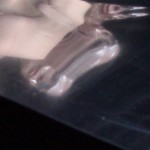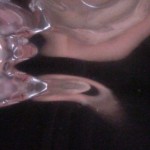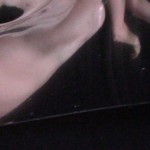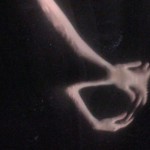Et boire une aquarelle fanée à même l’eau vaseuse du pot de chambre qui tremblote; à marée noire, écaille, poisson
Video
5 min. 04
2020
Camera, editing, music: Belinda Campbell
text:Nathalie Bachand
Translation: Jennifer Westlake
The act of drinking is movement: Water and body, in motion. To drink is to meet a body of water, embody it, become one with it. Accompanied only by the sound of a piano, a body moves through space, unfolding, multiplying, and dividing. Flesh crosses a surface. Uncertain, the body shifts itself. As the piano keys are pressed, the encroaching volume of this body seems to follow the notes as they are struck, reshaping itself as they stretch out. Like prolonged soundwaves resonating in concentric circles on a still body of water, these sounds move through the muddy body as it crosses the image.
Created with mirror paper and a small camera that can shoot from a sharp angle, the elusive subject inhabiting this work evokes Yōkai — Japanese demons and spirits. The gaze and hands that we meet here reveal a fragile, febrile humanity, a humanity that will either be born or succumb. Each movement in this disquieting choreography is liquified at every random turn. The improbable being evolving under our eyes may only be a part of a void after all — or maybe it belongs to the black tide evoked in title.
In this work, the construction/deconstruction of the body that has animated Campbell’s practice for several years is almost quasi-digital. Having dropped away from the frontal, direct shots that usually incarnate a presence, here the performative element falls in with a system of moving images and controlled revelations and concealments. Leaving aside the filter of our gaze, which has been broken down into an abstract pattern of 0s and 1s that models and replicates everything, there is nothing digital about this effect. The artful framing of these reflections is all that’s needed to distance the created image from its source, the body, and generate the work’s preternaturalness.
And yet, by confounding the points of reference that usually guide our understanding, this distance allows us to comprehend the body as substance, more than an identity. At a cellular, corporal level, the body has a reality that sidesteps every attempt at constructed stability, escaping the way water seeps into even the finest cracks in reality.
Et boire une aquarelle fanée à même l’eau vaseuse du pot de chambre qui tremblote; à marée noire, écaille, poisson
Vidéo
5 min. 04
2020
Caméra, montage, musique: Belinda Campbell
Texte de Nathalie Bachand
Boire est mouvement. Mouvement d’eau, mouvement de corps. Boire est s’approcher au plus près de l’eau, faire corps avec, être l’eau. Au seul son du piano, un corps se déplace, se déploie et se démultiplie, se subdivise aussi. Une chair avance sur une surface. Une chair incertaine se meut. Les volumes pervasifs de ce corps semblent se former/reformer en suivant la pression des notes de l’instrument, l’étirement des sons, leur ampleur. Tout comme l’onde sonore prolonge sa résonance dans les cercles concentriques d’une eau calme, le son ici traverse le corps vaseux qui lui, traverse l’image.
Créée à partir de papier miroir et d’une caméra légère ayant permis de capter l’image depuis un angle particulièrement prononcé, la présence fuyante qui habite l’œuvre évoque les contours de certains Yōkai, ces démons et fantômes de la mythologie japonaise. Puis nous rencontrons ce regard et ces mains qui dévoilent une humanité fragile, fébrile. Une humanité à naître ou à disparaître. Dans cette inquiétante chorégraphie où chaque mouvement se liquéfie en sa suite impensée, l’être improbable qui évolue sous nos yeux n’appartient peut-être qu’au néant après tout – ou encore à cette marée noire qu’évoque l’intitulé.
Le processus de construction/déconstruction du corps qui anime la pratique de Campbell depuis déjà plusieurs années se rapproche ici d’un travail quasi numérique de l’image : ce qui est performatif quitte l’incarnation habituelle de la présence, du frontal et du direct, pour rejoindre le régime de l’image en mouvement et du contrôle de ce qui est montré-caché. Or rien dans cet effet n’est numérique sinon le filtre de notre regard désormais rompu à l’abstraction des 0 et des 1 qui modélise et dédouble les objets du monde. Le fin travail de cadrage du reflet suffit amplement à éloigner l’image donnée de l’objet source – le corps – et à générer l’étrangeté à l’œuvre.
Cette distance qui brouille nos repères de lisibilité permet cependant de comprendre un corps comme une substance plus qu’une identité : sorte de réalité cellulaire de la corporéité échappant ici à toute tentative de construction et de stabilité, fuyant comme l’eau s’infiltre dans les moindres failles du réel.
montage from Belinda Campbell on Vimeo.




